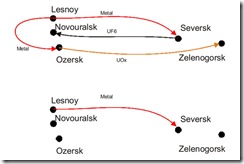International Panel on Fissile Materials just published my paper on consolidation of Russia's nuclear complex. It is an overview of the current status of the nuclear complex and some suggestions on what can be done to consolidate fissile materials to make them more secure.
Most recommendations are hardly controversial - reduce the number of sites that work with weapon-grade materials, clean out small research facilities, convert research reactors to LEU fuel. I tried to come up with some proposals that would facilitate this process.
There are two things that I want to mention. One is that preference should be given to securing military fissile material at the existing sites. There are four or five of them, each holding tens of tonnes of HEU and plutonium. Consolidating this material at a smaller number of sites would mean transporting tens and probably hundred tonnes of material across the country - hardly a secure option. Moreover, the material can and should be secured even if we don't know how much material is in storage. It is important to eliminate the movements of material - we could always count it later.
 From the point of view of material transfers, we should recognize that the HEU-LEU program (also known as Megatons to Megawatts) is an insanity from the security point of view - it creates a net security risk by taking weapon materials from storage and then sending it several times across the country. There is no way this program reduces the risks associated with HEU (I wrote about it in more details in a Bulletin column last year). The right thing to do would be to terminate the program as soon as possible, but that is politically impossible - everybody counts on its running through 2013 as planned. The next best choice is to restructure the program to eliminate unnecessary flows of HEU. The diagram on the left shows how this would change the amount of HEU shipments.
From the point of view of material transfers, we should recognize that the HEU-LEU program (also known as Megatons to Megawatts) is an insanity from the security point of view - it creates a net security risk by taking weapon materials from storage and then sending it several times across the country. There is no way this program reduces the risks associated with HEU (I wrote about it in more details in a Bulletin column last year). The right thing to do would be to terminate the program as soon as possible, but that is politically impossible - everybody counts on its running through 2013 as planned. The next best choice is to restructure the program to eliminate unnecessary flows of HEU. The diagram on the left shows how this would change the amount of HEU shipments.

Comments
Pavel,
Your consolidation proposal is motivated by non-proliferation. What do you think about the overall restructuring effort recently aired before Putin (as far as I recall from the news it cited merging NIIA and NIIIT, for instance)?